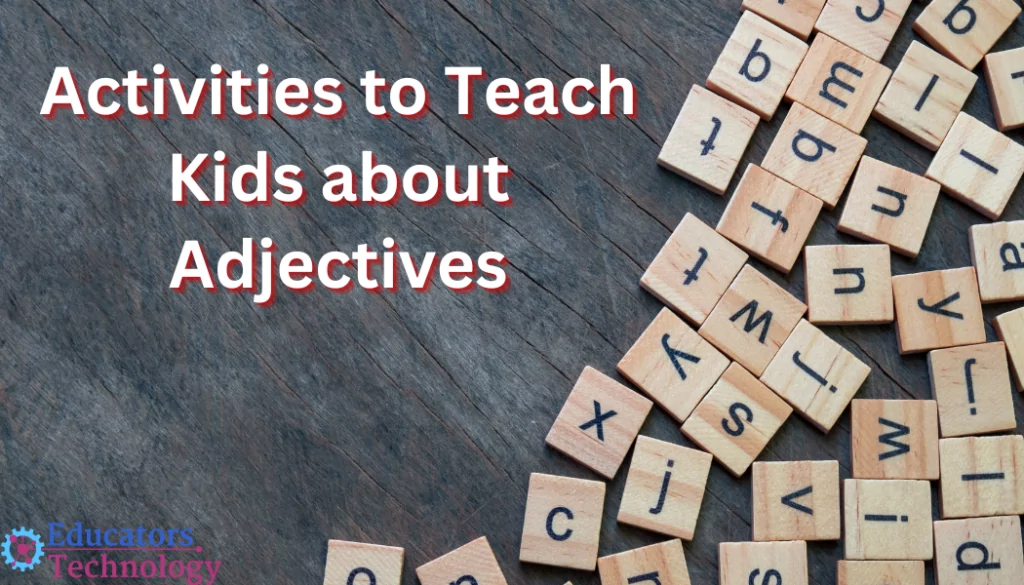Activities to teach kids about adjectives are the topic of our blog post today!
In a previous post, we delved deep into the world of adjectives, dissecting what they are, their varied types, and examples for each. But as we all know, understanding the theory is just half the battle. Now it’s time to put that knowledge into action. Enter the hands-on, engaging world of activities designed to teach kids adjectives in the most effective and memorable ways.

Sure, adjectives help spice up our sentences, but they also serve as vital tools for kids to express themselves clearly and enrich their language skills. Today, we’ll be exploring a myriad of activities that not only make the learning of adjectives fun but also engrave them into our little ones’ memories. From ‘Adjective Bingo’ to ‘Paint-By-Adjective,’ we’ve got activities that will suit every teaching style and learning preference.
The Importance of Teaching Kids Adjectives
When we think about language development, we often focus on basic skills like reading, spelling, and simple sentence formation. However, adjectives are one of the often-unsung heroes that take language from merely functional to expressive and dynamic. Understanding and using adjectives contribute to a well-rounded language skill set, enriching communication in significant ways.
Here are some of the benefits of teaching kids adjectives:
1. Amp Up Communication Skills
One of the most immediate benefits is the enhancement of communication skills. Adjectives give depth and detail to a simple sentence. Instead of “I have a dog,” you can say, “I have a playful, energetic dog.” This enriched sentence gives a fuller picture and allows for a more meaningful connection between the speaker and the listener.
2. Cultivate Creative Thinking
Using adjectives also fosters creative thinking. Kids have to delve into their vocabulary banks to find the perfect word that encapsulates their feelings or describes an object. This activity is akin to mental gymnastics and is a great exercise for their brains.
3. Boost Reading Comprehension
Reading comprehension is another area where a good understanding of adjectives comes in handy. Adjectives often play a vital role in setting the scene and building the imagery in a text. When kids understand the adjectives in a passage, they have a better grasp of the material.
4. Enhance Writing Skills
Strong writing is often characterized by its vivid descriptions that engage the reader’s senses and emotions. Knowing how to use adjectives effectively can transform a student’s writing from mundane to captivating.
5. Emotional Intelligence
Let’s not forget emotional intelligence. When kids can accurately describe their feelings using adjectives, they’re better equipped to understand and manage their emotions, which is a critical life skill.
Activities to Teach Kids About Adjectives
Here is a collection of hands-on, interactive activities that make the abstract concept of adjectives come alive for kids:
1. Adjective Show and Tell
Adjective Show and Tell has the kiddos bring in an object from home and describe it using a slew of adjectives. This adds a personal connection to the activity, making the lesson stick in their minds while they also get to learn more about each other’s interests.
2. Adjective Bingo
Adjective Bingo spins the classic bingo game into an adjective-learning experience. Instead of numbers, the bingo cards are filled with different adjectives. You read out sentences, emphasizing the adjective, and they mark it off if it’s on their card. Instant engagement right there!
3. Paint-By-Adjective
Paint-By-Adjective gives a fun twist to the typical coloring activity. Instead of the usual color names, you jot down adjectives. The young learners have to use their creative noggin to figure out which color each adjective corresponds to. Talk about a fun way to make them think!
4. Adjective Scavenger Hunt
Adjective Scavenger Hunt turns the classroom or even the entire school into a playground for learning. Armed with a list of adjectives, the kids go on a hunt to find items that match those descriptive words. It combines physical activity with a mental workout, making it a double win in my book.
5. “Whose Is It?” Game
The “Whose Is It?” Game creates an intriguing guessing game based on adjectives. You list out various adjectives that describe a student in the class—like “kind” or “tall”—and the rest of the class has to figure out who it is. It’s a great way to foster community while simultaneously reinforcing the idea that adjectives serve as identifiers.
6. Adjective Charades
Adjective Charades adds a twist to the classic game by focusing on adjectives. Instead of acting out a phrase or title, kids act out an adjective while their classmates try to guess it. This amps up the fun factor and provides a whole new avenue for kids to understand and internalize what adjectives are all about.
7. Comparative and Superlative Race
Comparative and Superlative Race takes learning about the different forms of adjectives to an interactive level. Kids line up in two rows and are given an adjective. They then have to convert it into its comparative and superlative forms as quickly as possible. This adds a time-sensitive, competitive element that makes the learning stick, all while they’re having a blast.
Related: 60 Funny Words for Kids
8. Adjective Memory Game
The Adjective Memory Game uses flashcards to help reinforce the relationship between nouns and adjectives. One set of cards has nouns, while the other set has adjectives. Students must match them up from memory, which not only sharpens their recall skills but also helps them understand how adjectives modify nouns, all in a fun, interactive setting.
9. Adjective Synonym Challenge
Adjective Synonym Challenge invites kids to stretch their vocabulary by finding more nuanced or intriguing synonyms for common adjectives like ‘happy’ or ‘sad.’ This game encourages them to dig deeper into the language and discover new ways to express similar concepts, making it an excellent tool for both vocabulary expansion and for understanding the subtle differences in meaning between similar adjectives.
10. Mad Libs
Mad Libs is a timeless game that’s perfect for teaching adjectives in a fun, interactive way. Create an adjective-heavy version where kids get to fill in the blanks with the most whimsical, bizarre, or sophisticated adjectives they can think of, turning simple sentences into colorful, vivid stories.
11. Story Time with Emphasis
Story Time with Emphasis turns the passive act of listening to a story into an active learning experience. As you read aloud, kids are prompted to jump up whenever they hear an adjective. This kinesthetic element not only keeps them engaged but also helps them tune in to the adjectives enriching the story, making it an auditory and physical learning adventure.
12. “Feel the Adjective” Bag
The “Feel the Adjective” Bag is a tactile game that allows kids to engage their senses. Various objects are placed in a bag, and kids have to reach in, feel around, and describe the object using adjectives before pulling it out to confirm their guesses. This activity is a sensory-rich way to explore adjectives, linking the descriptive words to real-world objects and experiences.
13. Adjective Pictionary
Adjective Pictionary takes the classic drawing game and adds a linguistic twist, focusing on illustrating adjectives instead of nouns. Kids are tasked with drawing scenes or objects that embody specific adjectives like “gloomy,” “radiant,” or “jagged,” making the game not just a test of their art skills but also a great way to expand their adjective vocabulary.
14. Fill in the Blanks
The Fill in the Blanks game offers kids a direct way to practice using adjectives in context. You provide sentences with missing words, specifically leaving out the adjectives, and then let the kids fill in the gaps. This activity is not just a fill-in-the-gap task; it’s a thought-provoking challenge that helps kids consider which adjectives best fit the context, encouraging them to think critically about word choice and sentence structure.
15. Adjective vs. Noun Sorting
The Adjective vs. Noun Sorting activity is an excellent hands-on way to help kids distinguish between these two essential parts of speech. Provide them with a mixed list of words, and have them sort each into its respective category—either “adjective” or “noun.” This task not only sharpens their understanding of what adjectives are but also how they differ from nouns in structuring sentences and conveying meaning.
16. Descriptive Diary
The Descriptive Diary activity turns the reflective practice of journaling into an educational goldmine for learning adjectives. Over the course of a week, students jot down adjectives that encapsulate their day, experiences, feelings, and observations. By the end of the week, not only do they have a vivid account of their days, but they also have a rich list of adjectives they’ve used in a meaningful, personal context. This bridges the gap between academic learning and real-world application, making the adjectives stick in their minds more effectively.
17. Adjective Song Lyrics
The Adjective Song Lyrics activity remixes familiar children’s tunes by leaving blanks for kids to fill in with suitable adjectives. It’s a musical and interactive way to teach adjectives, blending the fun of singing with the educational benefit of word replacement, enhancing both their vocabulary and their understanding of how adjectives add flavor to language.
18. Word Wall
The Word Wall is a living, evolving display that serves as a communal resource for learning adjectives. Throughout the school year, students can add new adjectives they encounter or find interesting to the wall. This not only builds a rich, collaborative vocabulary list but also keeps students engaged and attentive to adjectives in various contexts, from reading assignments to daily conversations.
19. Peer Review with Adjectives
In the Peer Review with Adjectives activity, kids swap their writing assignments to specifically critique the use of adjectives. It’s like a typical peer review but with a laser focus on how well adjectives were employed to enhance descriptions and add depth to the narrative. This exercise hones in on both the analytical skill of critiquing and the creative skill of writing, helping kids see adjectives from the dual perspectives of a writer and a reader.
20. Adjective Recipe Book
Have each student pick a simple recipe and write it down, but they have to leave blanks for the adjectives. Then swap the recipes among students, and have them fill in the blanks with appropriate adjectives. For instance, instead of just “apple,” they could write “crunchy apple,” or instead of “cake,” it could be “fluffy cake.”
Final thoughts
In the list above, I featured a number of activities that can help make the teaching and learning of adjectives a memorable experience. By combining both theory and practical application, we set the stage for a deeper, more holistic understanding of this crucial aspect of language. The activities range from the artistic to the analytical, ensuring there’s something to capture every child’s interest.




